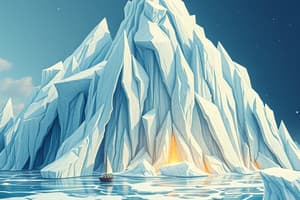Podcast
Questions and Answers
What is formed when the ocean surface cools to the freezing point of seawater?
What is formed when the ocean surface cools to the freezing point of seawater?
- Lead
- Polynya
- Permafrost
- Sea Ice (correct)
What term describes the large areas of open water within a sea ice pack?
What term describes the large areas of open water within a sea ice pack?
- Polynya (correct)
- Outwash
- Lead
- End Moraine
Which feature results from the divergent movement of thin ice cover?
Which feature results from the divergent movement of thin ice cover?
- Till
- Permafrost
- Pressure Ridge (correct)
- End Moraine
What is the active layer in permafrost regions?
What is the active layer in permafrost regions?
What is the term for the material deposited directly onto the ground surface by a glacier?
What is the term for the material deposited directly onto the ground surface by a glacier?
Which type of moraine is formed at the terminus of a glacier?
Which type of moraine is formed at the terminus of a glacier?
Which type of water is formed due to the exclusion of salt as seawater freezes?
Which type of water is formed due to the exclusion of salt as seawater freezes?
What causes land surface movement and instability in periglacial zones?
What causes land surface movement and instability in periglacial zones?
Which landform is not associated with moraines?
Which landform is not associated with moraines?
What percentage of the Earth’s land surface is covered by the cryosphere?
What percentage of the Earth’s land surface is covered by the cryosphere?
What is the primary characteristic of hard water?
What is the primary characteristic of hard water?
Which of the following is a feature of karst landscapes?
Which of the following is a feature of karst landscapes?
Where is the majority of the polar ice located in the southern hemisphere?
Where is the majority of the polar ice located in the southern hemisphere?
What does the snowline indicate?
What does the snowline indicate?
What is not a component of the cryosphere?
What is not a component of the cryosphere?
Which chemical process is primarily responsible for the formation of caves in limestone?
Which chemical process is primarily responsible for the formation of caves in limestone?
Flashcards are hidden until you start studying
Study Notes
Sea Ice Formation and Dynamics
- Sea ice forms when the ocean surface cools to seawater’s freezing point, impacting global ocean circulation and climate.
- Constant motion of sea ice is driven by winds and ocean currents, leading to structural changes.
- Divergent movement causes ice to break, forming linear openings called leads.
- Large areas of open water within sea ice are referred to as polynyas.
- Fractured ice shears and piles into raised formations known as pressure ridges.
- Freezing seawater excludes salt, generating cold, saline, and denser water that contributes to deep ocean water formation, such as Antarctic Bottom Water.
Periglacial Landscapes
- Periglacial zones are land areas beyond glacial limits where temperature and frost significantly shape landscapes.
- Permafrost is perennially frozen ground, consisting of soil, sediment, and bedrock, remaining below freezing for extended periods (-5° to -10°C).
- Most permafrost formed during the last glacial age, with notable fossils of woolly mammoths found within.
- In summer, the active layer of permafrost thaws, creating land surface instability and movement.
Glacial Deposits
- Glacial movement results in the deposition of materials beyond the equilibrium line.
- Till directly deposited on the ground surface is called basal till.
- End moraines, which are ridge-like sediment accumulations along glacier margins, consist of two types: terminal moraine and lateral moraine.
- Outwash refers to material transported and deposited by glacial melt-water.
- Moraines lead to specific landforms, including kames (small stratified hills) and kettles (closed basins from melting glacial ice).
Earth's Snow and Ice Cover
- The ocean's vast expanses give Earth its bluish color from space, contrasting with the polar regions' white snow and ice cover.
- In the northern hemisphere, ice floats as a thin sheet on the Arctic Ocean.
- The southern hemisphere features a vast glacier system over Antarctica, with surrounding floating sea ice extending beyond the coastline.
- Polar ice contributes to the generation of cold, dense water critical for deep ocean circulation and climate regulation.
- The cryosphere, accounting for nearly one-third of the Earth's land surface, includes glaciers, sea ice, and frozen ground.
- Components of the cryosphere encompass:
- Greenland Ice Sheet
- Antarctic Ice Sheet
- Ice shelves
- Sea ice
- Permafrost
- Mountain-based ice caps and smaller glaciers
Snow Coverage
- The greatest snow cover occurs in continental climates at middle and high latitudes, and in high-altitude regions.
- The snowline defines the lower boundary of snow within the annual snow cycle, influenced by altitude, temperature, and moisture availability.
Water Chemistry of Groundwater
- Groundwater commonly contains dissolved minerals and compounds derived from weathered rock material.
- Groundwater that traverses limestone is rich in calcium and magnesium bicarbonates, termed hard water, which does not lather with soap.
- Soft water contains minimal dissolved matter with negligible calcium content.
- The mineral content of spring water reflects the geological strata where it sources its minerals over varying time scales.
Geological Work of Groundwater
- Rainwater’s slight acidity enables it to dissolve calcite, leading to the creation of karst landscapes featuring caves and sinkholes.
Studying That Suits You
Use AI to generate personalized quizzes and flashcards to suit your learning preferences.




